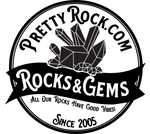Dichroscope Instructions


A gemstone or mineral that displays a different color depending on the orientation of the stone is said to be pleochroic. This phenomena is the result of different wavelengths of light being absorbed in different amounts in different directions. If the light traveling through a stone stays in one ray, that stone is singling refractive. If light divides into two rays, it is said to be double refractive (or dichroic.) In a few rare cases, stones will show 3 colors. These are called trichroic.
Dichroscopes are used to determine pleochroism in gemstones. It can also be used on rough (or uncut stones) to id or determine the best orientation for cutting the stone.
Step 1:
Place the side (girdle) of the gemstone in front of the aperture, almost touching the dichroscope, with a strong white light behind the stone. You will see two small squares side by side.


Step 2:
While you are looking through the dichroscope,compare the two squares. Are the squares are the same color? The color difference can be fairly slight, so look carefully. Next, turn the dichroscope 180 degrees noting any changes in color to the squares.
Step 3:
Repeat this process while looking through the girdle (side) of the stone in two directions, and from the top (or table)of stone, and two side top facets. (See diagram.) Pay close attention to any changes to the color of the squares.
Step 4:
The number of different colors determines the refractivity and pleochroic properties of the stone. Look carefully! Sometimes the color change can be very slight.
Pro tips:
- The strength of the colors shown is also important to identification. Weak or strong pleochroism play a role in helping determine the identity of the gemstone.
- Take care in choosing your light source, flourescent light can give a false reading for very weak pleochroism even in stones that do not have pleochroism.
- The aperature end of the dichroscope looks like a hex nut. To know which end you look through, just remember there should be a nut at each end!
- Remember: Always complete at least three tests when identifying a stone. No one test is conclusive.

